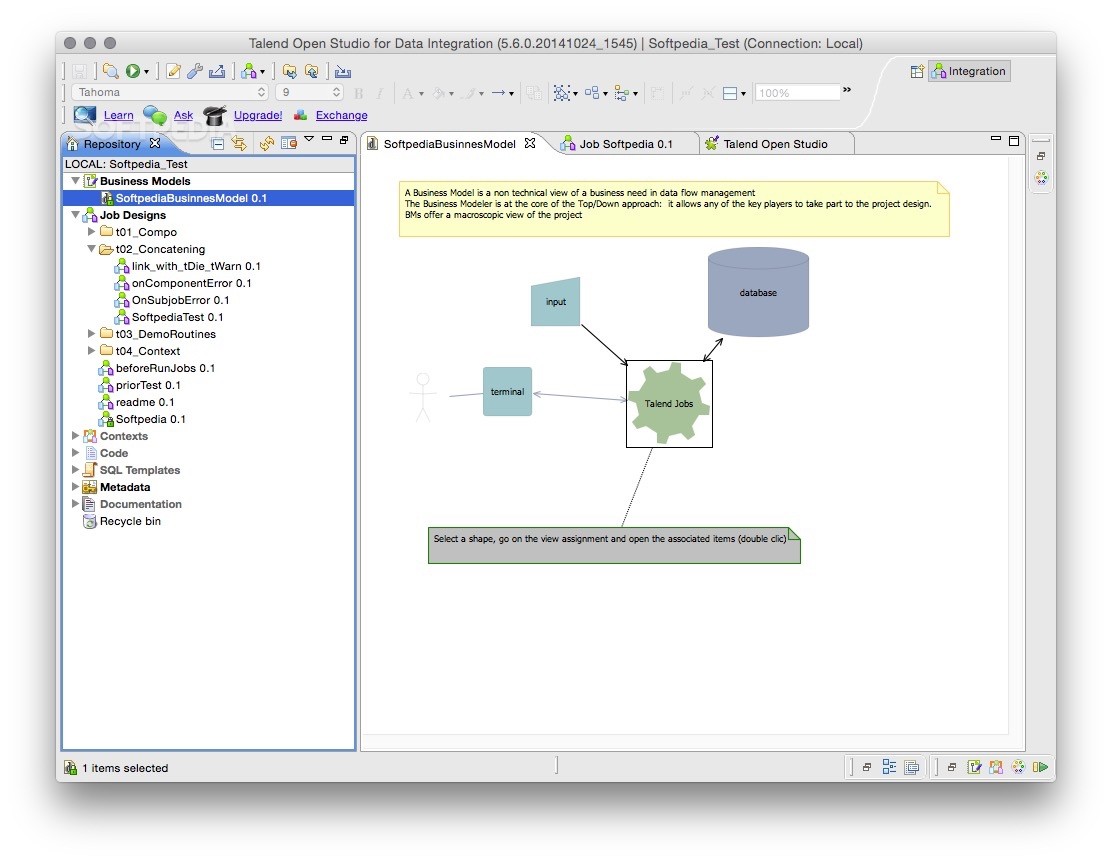Talend is a powerful tool, but learning the basics can be difficult.
Thankfully, there is a growing number of resources online to help you learn Talend Studio.
Here are 7 of the best resources for new and aspiring Talend developers and designers.
1. Talend’s official tutorials (at TalendForge.org)
Do you like to dive straight in and start building something instead of reading a manual? Then the official tutorials are a great place to start.
Talend Open Studio for DI/DQ/BD opens up on a four-panel window. The Repository is the left panel storing all items used to model your business and design your processes. You can define various preferences according to your needs. Download Talend Open Studio today to start working with Hadoop and NoSQL. Connect to any data source in batch or real-time, across any platform. Download Talend Open Studio today to start working with Hadoop and NoSQL. Mac Download. Simplify ETL for large and diverse data sets View Details. Windows Download. Mac Download.
Not only do you learn from the people that made the product itself, but they are like complete walkthroughs on how to implement a solution from start to finish.
Unfortunately some of the tutorials are a bit out of date, and there aren’t any tutorials yet that focus specifically on Talend ESB.
But, for picking up the basics of Job design and getting your hands dirty, it’s a great place to start.
The ones I particularly recommend are:
See more tutorials at Talendforge.org.
2. Talend by Example
This site is a fantastic resource.
Written in plain English, it’s full of useful information about what the components do, and how to incorporate them into your jobs.

Some advanced Talend topics are also covered here, such as context variables, error handling and performance.
The author goes the extra mile to provide justification for the way he chooses to develop Talend jobs, based on his own practical experience. Highly recommended.
3. Talend Help Center, for official documentation
The Talend Help Center is the official hub for full documentation from all recent Talend releases.
Talend Open Studio Source Code
Once you’ve registered, you’ll be able to browse the entire documentation library. Each release of Talend has a range of different manuals, each focused on a different topic, such as components, or administration.
You’ll be referring back to the documentation lots of times, especially when you need to find out what each component does, and what settings you should choose.
Tip: Download the full PDF versions of the Talend manuals to your computer and make your own highlights and annotations using a tool like Foxit Reader (Windows) or Preview (Mac). Then you’ll be able to keep track of all your learning notes in one place.
4. Talendforge user forum
The Talendforge forum is a good place to ask technical questions.
There is a different forum for each Talend product. The forums you’ll most want to ask questions in are the Open Data Integration - Usage, Operation forum, and the ESB product usage forum.
Some of Talend’s own staff monitor the forum and sometimes answer questions.
Tip: You can also post questions onto Stackoverflow, or browse the questions asked there.
5. Talend blogs
Blogs are a good place to learn from developers and consultants who are out there using Talend on the job. The better ones will walk you through a solution step-by-step, and are a good place to leave comments or questions for the author.
There aren’t many Talend dedicated blogs out there just yet, but the two best ones are definitely Vikram Takkar’s Tech Cafe and some of the older posts on Bekwam Blog.
6. Apache Camel web site and mailing list
This one’s for you if you’re learning the Talend ESB edition. In case you didn’t know, the Mediation perspective, where you create Routes, is based mostly on Apache Camel, an open source integration framework.
Camel has its own extensive online documentation with example code and scenarios (some of this is incorporated directly into the Talend documentation itself). There’s also a busy users’ mailing list where you can get answers from some of the Camel developers themselves.
Although the Camel web site focuses mostly on using it as a standalone framework, it will speed up your Talend ESB learning curve massively if you have a good understanding of the underlying concepts from Camel.
Apache Camel web site and Apache Camel users’ forum.
7. Books!
Make your bookshelf happy, or decorate your cubicle, by purchasing a decent technical reference book that you can dip into.
Here are three Talend related books that I’ve read and can highly recommend:
Talend Open Studio Cookbook - This is one of the very few books focused on Talend. It’s structured as a set of recipes which show how to implement some common scenarios in Talend, like calling a web service, or transforming some XML, or how to work with databases.
Camel in Action - Written by those who created Camel, this book is an excellent way to get to grips with the underlying framework on which Talend Mediation Routes are built. Great for understanding topics like error handling. A new edition of this book is in production and will be coming out soon.
Enterprise Integration Patterns - Long regarded as one of the most influential books on integration. The work Hohpe and Woolf did in this book forms the core foundation of Talend Routes (Apache Camel) - with components such as Splitter, Message Router, and so on. If you are relatively new to the world of message-based integration, this book is an essential read.
Talend Open Studio Tutorial Pdf
Tip: Read these books and more online by subscribing to Safari.
Talend Open Studio For Mac
Hope you’ve found this list of Talend learning resources useful. Found anything else you’d like to share? Please add it in the comments!